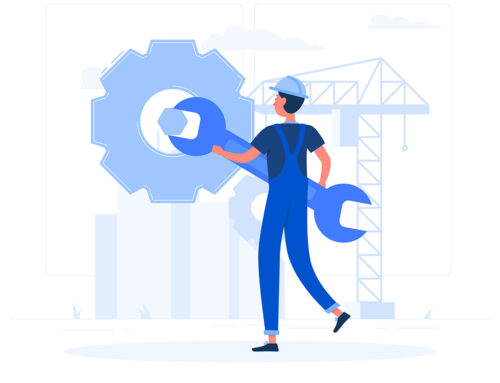The goalpost for B2B e-commerce is shifting. It’s not enough to simply offer online options for sales.
Author Nick Saraev

Photo: Freepik
Over 65% of B2B companies have e-commerce options in place. In order to stand out, you need to ensure your online platform is efficient, customer-centric, and optimized for expansion.
Javier Rodriguez, the Senior Vice President of Digital Strategy at ABB, recently shared his team’s path to revolutionising their B2B e-commerce. By explaining their process and path to success, he revealed the most effective ways to streamline your process and make a system that lasts.
The State of the Union: Where ABB Started
Before they focused on revolutionising their e-commerce, ABB’s digital presence was quite scattered. They were running multiple webshops with varying degrees of success.
While it may seem ideal to entirely re-build these back systems and replace them with something more digital-ready, this wasn’t an option. ABB’s factories, core processes, and value propositions were all running on these systems.
While this e-commerce process wasn’t ideal, it was bringing in results. The company was selling $25 billion worth of products digitally every year.
Making Progress: ABB’s E-Commerce Now
Over the past three years, Rodriguez’s team has transformed their platform to create a unified process that puts the customer first.
The major value that their B2B e-commerce platform provides is in its ability to streamline the purchasing process. Businesses can find what they need faster, making everything more efficient and cost-effective.
This shift is most clear in three core areas.
Proper Technology
The ABB Shop features architecture that’s flexible, multifunctional, and low-cost. The entire system is compatible with the fragmented landscape of their legacy systems, meaning they can compile data without stopping core functions.
Rather than working to invent entirely new systems, they borrowed from the success of other companies like Microsoft and Adobe. By finding the experts in each individual field and using their expertise, ABB was able to design the perfect system without breaking the bank.
Global Scaling
Since starting its digital transformation journey, ABB has expanded its upgraded e-commerce to 15 countries in just six months. Even as they continue to expand the program’s reach, they maintain one global code and central operation.
With this standardized system, ABB is able to introduce its e-commerce solution to a new country in just two weeks. This time is spent translating the interface and setting up logistics for order fulfilment.
Sales Efficiency
Over 50% of orders have converted to online, and digital accounts for roughly 25% of their revenue. This points to lower-value sales naturally moving online.
The growth is not necessarily seen on the bottom line, as most sales are simply migrating from offline to online. However, the overhead is significantly reduced as efficiency peaks.
Four Steps to Revolutionizing B2B E-Commerce
This widespread success didn’t happen overnight. ABB’s e-commerce department followed these clear steps to ensure their changes were effective.
Step One: Create a Clear Mandate
Rodriguez’s team met with their managers and defined what they would be working toward. They landed on crafting a blueprint for the organization, implementing the plan effectively, and reporting back with as much transparency as possible.
The core guidelines the team followed were
- Meet Customer Expectations – Any changes made should be customer-centric, rather than focus on the sales side
- Protect Existing Channels – This process is not a change in business model, simply an enhancement of what already existed
- Fact-Based Decision Making – Sales is an inherently emotional side of business, but the team committed to data-driven decisions
With these in place, the e-commerce team was ready to start designing a customer journey.
Step Two: Understand the Voice of the Customer
In order to create a process that was truly customer-centric, Rodriguez’s team wanted to hear from customers directly. This would help them align all stakeholders, set their priorities, and ensure focus throughout implementation.
To tap into the zeitgeist of their customers, they conducted a global survey of 3000 customers across 16 countries. They discovered that their customers wanted
- A single, modern, global webshop experience
- The ability to self-serve, research, and buy on their own
- A system for OEMs to punch-out
- A marketplace for channel partners
With these core functions in mind, the team could work toward transformation that made a difference for the customers.
Step Three: Define the Role
When Rodriguez’s e-commerce team started their work, ABB already had a successful IT department, as well as a finely tuned business operations team. The e-commerce team was focused on being a catalyst between these two groups.
When you create a clear boundary between what you are doing and what you aren’t responsible for, you can stay on track to create the changes that have to happen.
Step Four: Assembling the Team
Change of any kind requires strong talent behind it. If you want a fast and effective upgrade of your B2B e-commerce systems, you need to work with the best talent available.
A key component of attracting this talent is explaining what you want to accomplish. Many digital natives will be excited by the project and want to get involved.
In Conclusion
Excellence in digital B2B sales isn’t simply about creating an online sales channel. You and your team need to craft a platform that is efficient, customer-centric, and poised for growth.
By following in ABB’s footsteps, you can streamline the upgrading process and see results faster than ever. Focusing on customers, working with them to expand your online offerings, and creating a platform that works across the globe will give you a major leg up.
Every step you take toward a fully optimized e-commerce system is a step towards operational excellence.






























